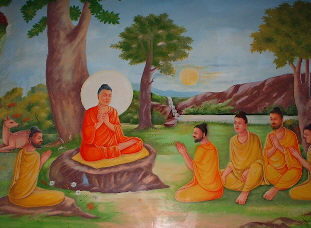
One of the hallmarks of human culture is its use of music to express just about every emotion and reflect the many variegated expressions of human activity such as religion, sexuality, nationalism or just having good old fun. At present, Chinese Buddhist music is emanating from the notebook on which this article is being written, and in response, feelings such as pleasure, devotion and peacefulness are inspired in my heart. Music is a powerful thing.
I recall that during the first Gulf War when
Most of us who have grown up in the West are familiar with the singing of Christian hymns. Sung with much fervor and devotion they are an integral part of most church services, encouraging loving feelings towards God and are also an expression of Christian identity. Monastics in the West have used plainsong or Gregorian chants to cultivate similar feelings accompanied by a reflective attitude to the songs. Go to any professional football match in
Of course, we listen to music for another good reason too: it’s enjoyable. Millions and millions of dollars are spent across the globe every year on the best-selling albums, and radios blast out the latest songs of the newest talent to hit the airwaves, along with older classics from the last century and beyond. Music is found in barn dances, weddings, discothèques, raves, birthday parties, stage shows, and of course, on the television. Mp3 players, i-pods, and even most video games contain music. My wife just purchased a new mobile phone that not only allows her to listen to mp3s but also lets her listen to the radio. Apparently, she can even make and receive telephone calls on the thing!
Listening to traditional Chinese Buddhist chants can reveal an important aspect of music that is usually overlooked: the space in between the notes. For, if all the sounds were drones going on and on simultaneously, it would be very difficult to discern any melody or rhythm in music. (And – unless distorted by modern technology – the human voice cannot drone on for much more than a few minutes, anyhow.) Even in music that uses drone-style sounds such as Indian music, only one instrument is normally used to make a droning noise which is used as a kind of background hum to the tunes played over it. And those tunes all have gaps in between the notes.
Let’s look closer at those gaps in music, for they point at an important aspect not only of sound but of life itself. Choosing a piece of music that isn’t too boisterous or chockablock full of many, many different sounds, devote this time to sitting down with an attentive mind and listening carefully. This can be done in a formal meditation position or sat or led down quite casually, as long as one doesn’t move around too much or become dozy and fall asleep. (Although, if you’re tired, why not go to sleep and do this experiment when less drowsy?)
Keeping pretty still and with eyes closed to cut out any visual interference with this experiment in sound, pay close attention to the chosen piece of music. Take in the various instruments on the song, focusing on each one in turn, noticing the particularities of the way they sound. For instance, one can listen to a bass guitar, recognizing its typically low muffled sound, creating a beat alongside any percussion being played. Also listen to the space in between the tune the bass is playing and see that the space is every bit as present as the bass guitar itself, but that normally we don’t place our attention on it so it goes unnoticed. Can you hear how the space not only lies in the gaps in between the notes of the music, but that it also surrounds them, never really going away – where can space go?! Indeed, prior to the first sound of the song there is space, and after the last note of the music has died away, space is present also. Space is here before the arising of sound, during the sound’s existence and after it has finished. Now, if you listen to the sounds that are arising where you are, there is also this peaceful silent space.
Unlike music, space doesn’t give us anything to grasp hold of and identify with. We can’t use space to express our nationalism, nor can it be used to illustrate our love of Jesus Christ, Amitabha Buddha or Sri Krishna. Space doesn’t inspire particular emotions such as love, hate, desire, loneliness, nor does it encourage the attachment that accompanies such feelings. Space is an openness which is experienced as the peace at the heart of the most discordant noise, and a void into which all sound falls eventually. If we focus on space, rather than the sounds that occur within it, we experience a widening of the otherwise limited human perspective. It’s difficult to react with any strong emotions to spaciousness; it is a void into which everything that we cling to as me and mine falls into.
Yet this isn’t as awful as it might sound, for if we let go of our attachments to sounds, sights, thoughts, memories etc, we experience them as they truly are, giving them the chance to express themselves in the fullness of being without interference from our ego. Then, we might well find that genres of music that previously were not appreciated can be heard in a more expansive way, without the negative presumptions of the ego to interfere. In the same vein, focusing on space can also help us to let go of negative feelings towards other human beings and creatures, making us less egotistical and reactionary. And even this ego itself can be seen in relationship to the void in which it appears, and we can know ourselves as we truly are perhaps for the first time, courtesy of the spaciousness that lies at our center.


